Here's the 411 on the TSA's 3-1-1 liquids rule

We've all been there. Waiting in the Transportation Security Administration line only to hear agents call for a "bag check," often because a traveler had a liquid product in their carry-on that's over the allowed limit (or some sort of other prohibited item).
It's a process that can sure slow things down, particularly on the busiest travel days. As you pack for your trip and consider what to put in your carry-on or checked luggage, it's important to consider what the TSA's limits are for liquids and similar products.
Since September 2006, the TSA has gone by the 3-1-1 rule when it comes to those types of products, including items like toothpaste, shampoo, conditioner, mouthwash and lotion -- sunscreen included.
For more TPG news delivered each morning to your inbox, sign up for our daily newsletter .
In short, the 3-1-1 rule is: Each liquid you bring through the TSA checkpoint must be in a 3.4-ounce or smaller container ("3"), all containers must be placed inside one clear quart-size plastic bag ("1") and each passenger is only allowed one plastic bag ("1").
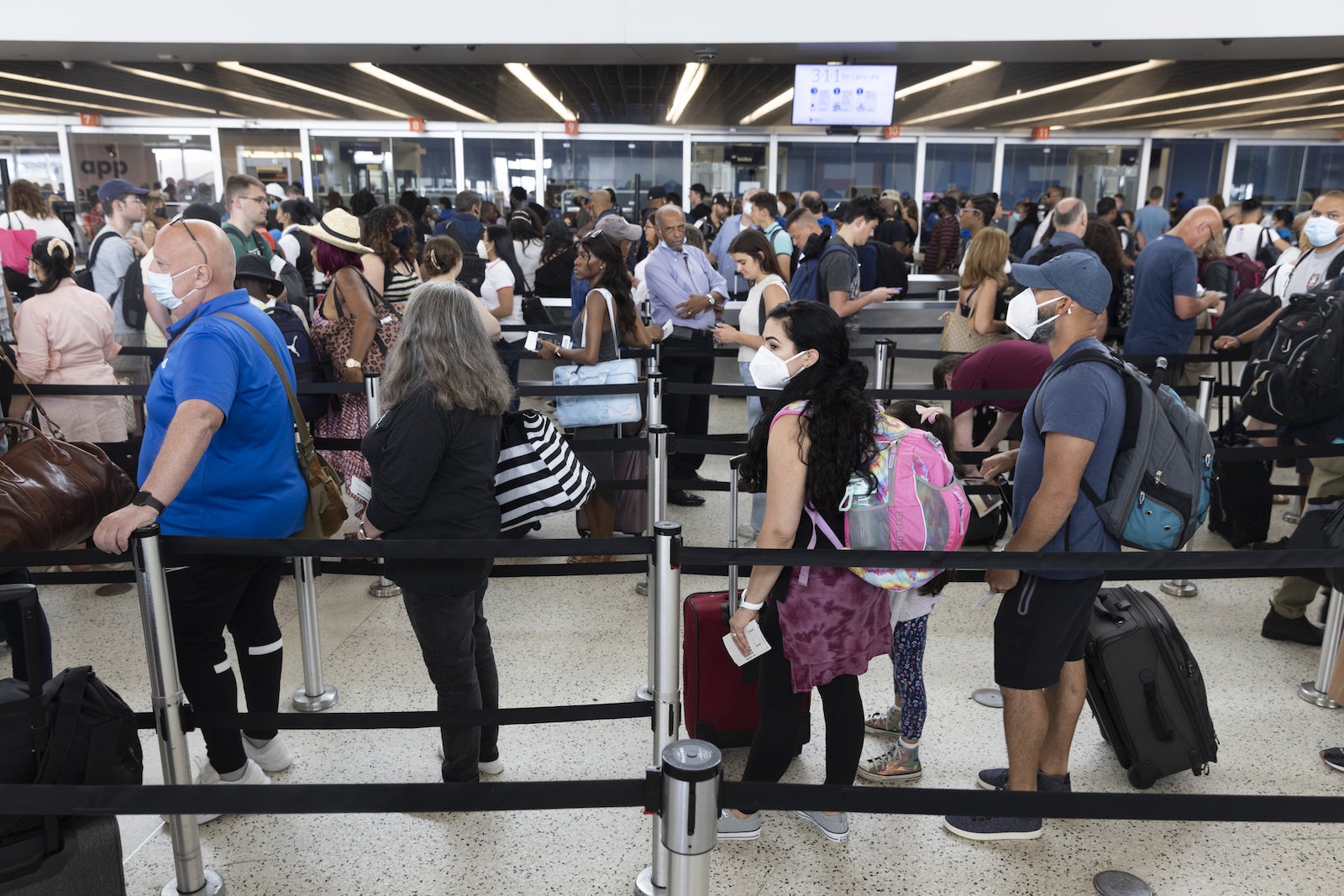
If you meet those requirements, you should get through security without issue. However, if your liquid items are larger than 3.4 ounces each, you'll have to leave them in your checked bag.
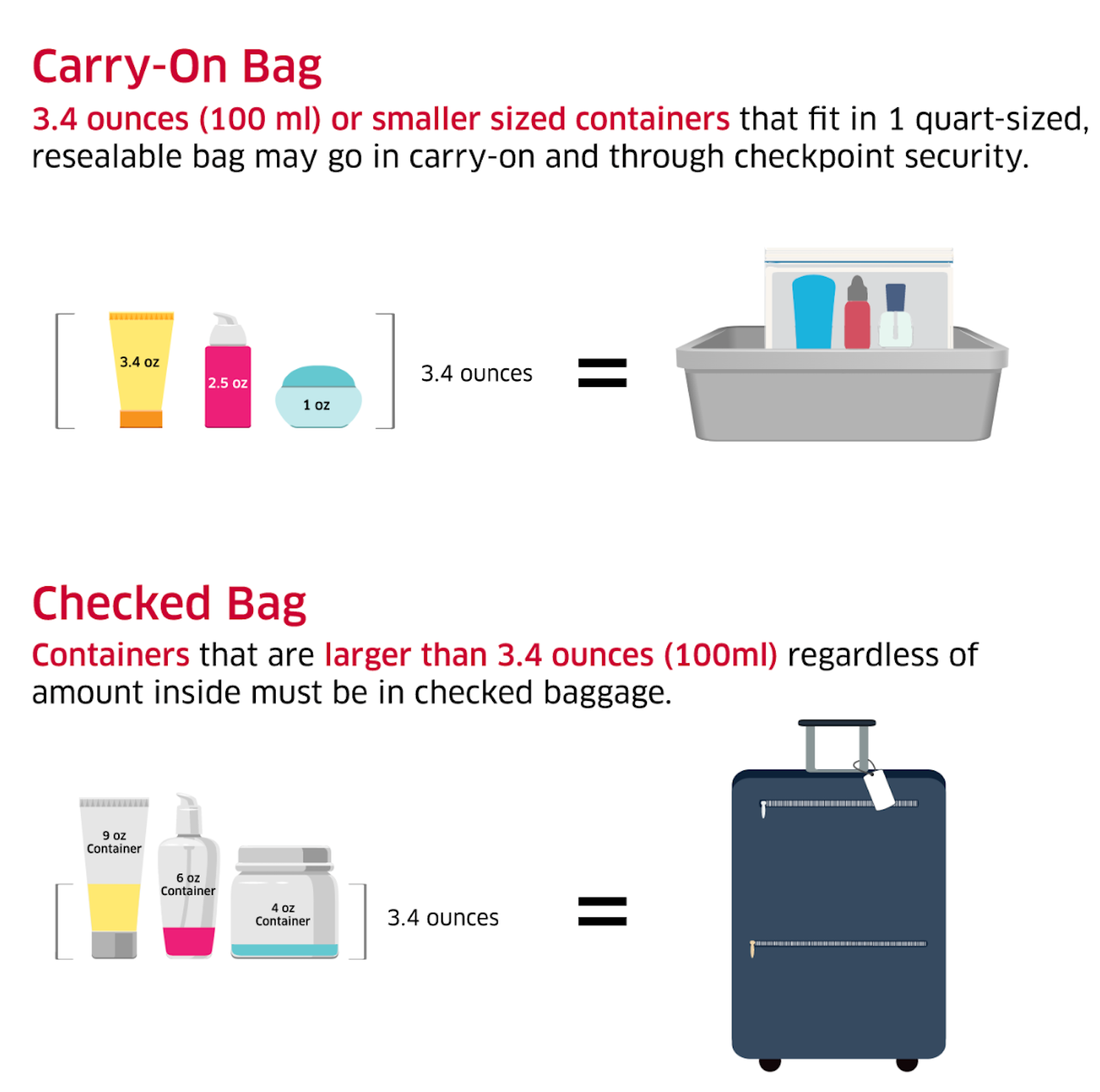
There are a few exceptions, though.
The TSA has kept in place a temporary pandemic exception to the rule, allowing up to 12 ounces of liquid hand sanitizer in carry-on baggage.
Part of this exception: The hand sanitizer will have to be screened separately since it's technically over the limit. You'll need to remove it from your bag before it goes through the scanner.
There are also exceptions for larger amounts of medically necessary liquids, gels and aerosols. You can bring those products in larger, "reasonable" quantities, the TSA's website says. However, you must declare those items to security officers at the checkpoint for inspection.
This could, obviously, take a little more time than if you're traveling without those items.
This exception doesn't include sunscreen, despite calls to relax sunscreen restrictions at TSA checkpoints. Like other liquid products, sunscreen bottles over 3.4 ounces must go in your checked luggage.
There are also many liquids you cannot bring with you .
You can bring creamy cheeses, liquid chocolate, liquid coffee, creamy dips and spreads, gravy, honey, hummus, ice cream, jam, jelly, juice, syrup, peanut butter, salad dressing, sauce, salsa, soda, soup and yogurt as long as they are in a container of less than 3.4 ounces according to the TSA .
Related: Should you get TSA PreCheck or Clear — or both?
And yes, you can bring your water bottle with you, even if it weighs more than 3.4 ounces — as long as it's empty. This can also be a great way to save money at the airport, since -- as the TSA points out -- many airports have filling stations for reusable water bottles.
When in doubt, consult the TSA's list of what you can carry through the airport and check with your airline.
Additional reporting by Clint Henderson and Sean Cudahy.


Everything You Need to Know About the TSA’s Liquid Limit
The tsa allows liquids under 3.4 ounces in your carry-on—but what’s considered a “liquid” isn’t always obvious..
- Copy Link copied

Don’t forget to remove your liquids when going through TSA screening.
Photo by Jaromir Chalabala/Shutterstock
Whether you’re a carry-on-only kind of person or not , knowing the Transportation Security Administration’s (TSA) liquid limits is essential for anyone who travels by plane in the United States. Yet understanding which of your toiletries, foods, and other items even count as “liquid”—let alone how best to pack them—can get confusing. Use this guide to understand the TSA’s rules and restrictions about liquids, common exceptions, and tips to help ensure your next airport security screening goes smoothly.
What is the TSA liquid limit?
The TSA’s liquid limit for carry-ons—known as the 3-1-1 rule—allows travelers to pack liquids, aerosols, gels, creams, and pastes under 3.4 ounces (100 milliliters) in their carry-on bags. Passengers are allowed up to one quart-sized bag per person , or roughly nine 3.4-ounce containers in a single quart-sized bag. Anything more will have to go in a checked bag or risk being tossed out.
If your liquids are stored in containers larger than 3.4 ounces, even if there’s only 3.4 ounces left inside the bottle, you can’t bring them through security.
Completely empty bottles, such as your reusable water bottle , are allowed through the TSA checkpoint since (spoiler alert!) they don’t contain any liquids at that moment.
Which toiletries TSA allows in your carry-on
The TSA allows all of the following common toiletries in your carry-on only in containers that are 3.4 ounces or less:
- Shampoos and conditioners
- Lotions and sunscreen
- Gel hair products
In other words: yes, you can bring toothpaste, deodorant, and sunscreen through TSA checkpoints but only if they are in travel-sized containers.
Powders and powder-like substances, including baby powder and some makeup items, aren’t restricted in your carry-on bag. But if you’re carrying more than 12 ounces (350 milliliters) of a powder, you’ll need to place it in a separate bin for X-ray screening, and it may be subject to additional screening—so it’s a good idea to budget an extra few minutes at the security checkpoint if you think this might happen.
Tips for packing your toiletries in your carry-on

To comply with TSA regulations, invest in small, reusable toiletry bottles, like these capsules by Cadence.
Courtesy of Cadence
Especially if you don’t have TSA PreCheck , it’s helpful to pack all of your toiletries in a quart-sized (or smaller) clear plastic toiletry bag for screening. Although improved airport technology means that far fewer air passengers (both in PreCheck and non-PreCheck lines) will have to take their liquids out out of their carry-on, it’s still helpful to have all of your liquids in one bag just in case you get pulled aside for additional screening. For an upgrade from that large Ziplock, we recommend the standard-sized Clarity Jetset Case from Truffle ($88), which has a clear window panel and is comparable in size to a quart-sized bag.
Since toothpaste is considered a liquid, paste, or gel by the TSA, most of us toss those tiny one-ounce tubes in our carry-on bags. However, if you want to ditch the hard-to-recycle packaging, consider toothpaste tablets, an ecofriendly alternative that’s not subject to the 3-1-1 rule. We like Humankind’s fluoride toothpaste tablets ($12), which resemble small mints and turn to paste when you crush them between your teeth. Matador has also recently released a reusable toothpaste tube ($10), which you can fill (and refill) with your regular toothpaste.
For travel toiletries that are easy to rebottle (like shampoo or body wash), consider investing in reusable bottles or containers so you can always keep your preferred brand on hand. Some of our favorite TSA-approved toiletry bottles include:
Buy Now: GoToob three-pack of 3.4-ounce bottles, $30, rei.com
These easy-to-fill, leakproof silicone tubes are ideal for shampoos, conditioners, lotions, and body washes. GoToob’s line comes in a variety of sizes, ranging from 1.7 to 6 ounces, and are easy to clean between refills.
Matador FlatPack
Buy Now: $13 for one or $35 for three, matadorup.com
Each three-ounce, TSA-approved bottle is made from a durable, waterproof, nylon-based fabric. Like GoToob, they’re leakproof and easy to fill, but thanks to their flexible, fabric-like design, they will shrink to their contents, taking up less space in your pack. >> Read the full review of the Matador FlatPack
Buy Now: $14 for one or $74 for six, keepyourcadence.com
The refillable travel containers by Cadence are small, leakproof “capsules” that click together with magnets. At 0.56 ounces, they’re best for makeup and toiletries you don’t need much of—like a weekend’s worth of shampoo or a week of that under eye cream you only need a dab of.
Foods are subject to liquid limits
The TSA’s 3-1-1 rule applies to food too, meaning you’ll need to make sure any foods that count as liquids, gels, or pastes (like yogurt, peanut butter, pâté, jams, or that tasty pimento cheese spread you tried to bring home from Charleston) are less than 3.4 ounces or packed in your checked bag. There are some exceptions, like frozen foods and juice for babies, and the TSA’s website is the best resource to check for specific items.
Exceptions to TSA’s liquids rule: Full-sized liquids that you can bring through security
The TSA has several important exemptions to its liquids rule. You’re allowed to bring full-sized bottles of the following:
Hand sanitizer: Due to the coronavirus pandemic, the TSA currently allows travelers to bring up to 12 ounces of hand sanitizer in their carry-on bags. These will be screened separately.
Medication: You’re allowed to bring medically necessary liquids, aerosols, and gels through security. This also includes the ice or gel packs you may need to keep your medications cool. You are not required to store these items in a plastic, resealable bag, but you should remove them from your luggage and let the TSA officer know what you’ve packed.
Baby formula and breast milk: Like medication, you can bring freezer packs to keep these items cool, and you should remove them from your luggage and notify an agent when you go through security. More baby-related exceptions? Gel or liquid-filled teethers and canned or jarred baby food.
Of course, the final decision on whether an item is allowed through the checkpoint rests with the TSA officer.
If you’re ever unsure about a specific item, the TSA’s website has a handy, searchable list of prohibited and allowed items worth checking before you travel. You can also now text the TSA with your questions.
This article was originally published in 2022. It has been most recently updated on March 21, 2023, with additional information.

- Skip to main content
- Skip to header right navigation
- Skip to site footer

milepro | travel like a pro!
travel smarter....travel like a pro!
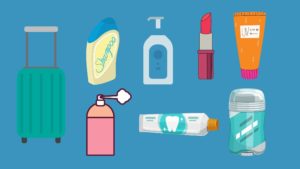
The TSA Liquids Rule for Carry-on Bags (3.4 ounces)
Tsa 3-1-1 rule, exceptions to the tsa liquids rule, tsa liquids rule for precheck, does tsa consider makeup a liquid, converting 3.4 oz to ml – how many ml is 3.4 ounces, what does 3.4 oz (100 ml) look like, converting 100 ml to oz – how many oz are in 100 ml, 100 ml to cups, 100ml bottle size – how big is a 100ml bottle, wrapping up: tsa liquids policy, more carry-on content:.
Before you finish packing to head to the airport, always double-check your carry-on bags and make sure you don’t have any bottles or other items that don’t comply with the TSA liquids rule, (known as the 3-1-1 rule).
By the time the TSA finds that expensive bottle of perfume or lotion in your bag, it’s too late and you’ll have to say goodbye and hand it over to get through security and board your plane on time. It’s happened to my family many times and could easily have been avoided with a quick check before leaving.
To help make sure this doesn’t happen to you, we’ve created this article that will tell you everything you need to know about the TSA liquids rule, including how much liquid is 100 ml, what are travel-sized bottles, what is considered a liquid, etc. Basically, all the stuff that could get confiscated when making your way through airport security.
What’s the TSA Liquids Rule?
The TSA liquids rule states that you can bring a quart-sized bag of liquids, aerosols, creams, gels, and pastes in your carry-on bag and through the airport security checkpoint. However, you are limited to containers that are travel sized and contain less than 3.4 ounces (100 milliliters) per item.
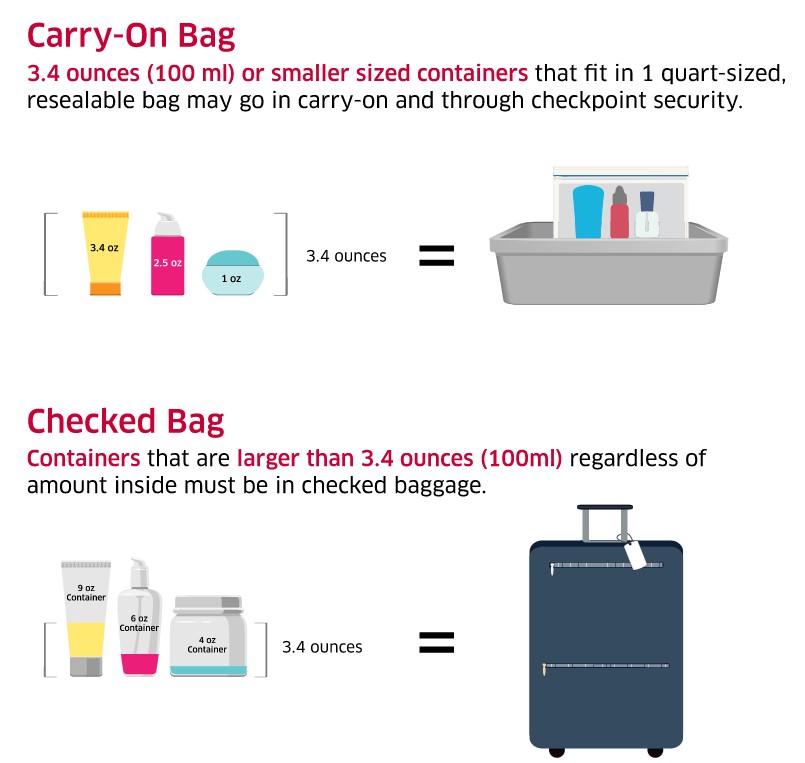
Items that are in packages or bottles larger than 100 milliliters (or 3.4 ounces) will have to go in your checked luggage . In addition to larger liquids, any liquid that is more than 3.4 oz or 100 ml and is not contained in a secure, tamper-proof bag must be packed in your checked luggage.
Each liquid must be in a 3.4-ounce or less container (“3”), all containers must be placed inside one clear quart-sized plastic bag (“1”), and each passenger is only allowed one plastic bag (“1”).
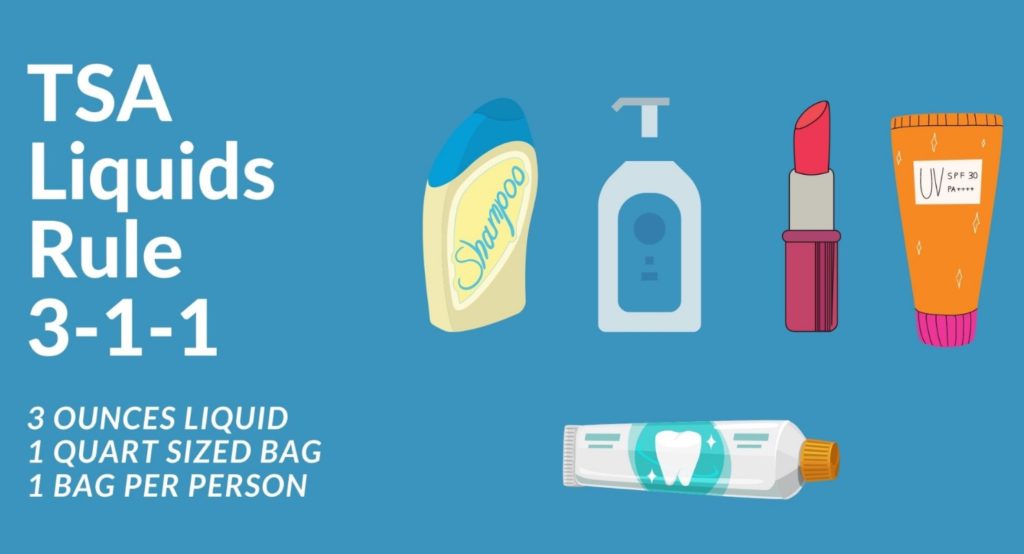
There are 2 exceptions to the TSA 3-1-1 Liquids Rule
- Medications, and
- Infant/Child nourishment
Medications larger than 100ml
TSA allows larger-sized packages of medical liquids, gels, and aerosols in your carry-on. This also includes medical accessories such as freezer bags, pumps, syringes, etc. These items do not have to be in a plastic zip lock bag, but you will have to declare these items to TSA officers at the checkpoint prior to inspection.
Here’s a video that provides all the details you need about traveling with medication.
Formula, Breast Milk, and Juice
Formula, breast milk, and juice for infants and toddlers are allowed through the security checkpoint. These can be in quantities greater than 3.4 ounces or 100 milliliters and are allowed in carry-on baggage.
Similar to medications, just inform the TSA officer of what you have and remove the items from your carry-on bag so they can be screened separately from the rest of your belongings.
Ice packs, freezer bags, frozen gel packs, and other accessories required to cool formula and breast milk are allowed in your carry-on bag.
The TSA PreCheck Program allows registered travelers the ability to go through expedited screening lines at over 200 participating U.S. airports with over 80 participating airlines. Once you are approved in the program you don’t need to remove your 3-1-1 liquids from your bag.
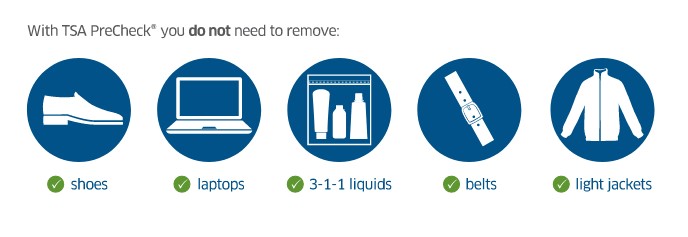
Actually, you can avoid removing any of the following items during the screening process:
- 3-1-1 compliant bag
- Light jacket/Sport coat/outerwear
- Laptop / iPad from bag
To apply for PreCheck, go to tsa.gov/precheck . From here you can enroll and make an appointment online or walk in at any one of over 380 enrollment centers . It can take up to 30 days to obtain a TSA PreCheck known traveler number.
What does TSA consider a liquid?
According to TSA guidelines, any substance that is free-flowing or viscous is considered a liquid. This includes liquids, aerosols, pastes, creams, and gels.
According to the TSA, “Makeup in a solid or powder form is allowed in carry-on and checked bags with no quantity or size limitations. However, when packed in carry-on bags, makeup in a liquid, lotion, gel, paste, or creamy form, must be in containers that are 3.4 ounces or less. You can take as many travel-sized liquids as you can comfortably fit into one quart-sized, zip-top bag.”
When it comes to makeup, the following are some examples of liquid cosmetics:
- Nail polish,
- Moisturizers,
- Foundation,
- Mascara, etc.

How much is 3.4 oz?
Now that you understand the basic concepts of the TSA liquid rule, it may help to have an idea of what constitutes 3.4 oz or 100 ml, since most people don’t naturally know how big a 3.4-ounce container or a 100 ml bottle is.
So if you’re wondering exactly how much is 3.4 oz or how big is a 100 ml bottle, we will walk through that for you here.
3.4 ounces (oz) converts to 96.388 milliliters (ml). For purposes of simplicity, the TSA rounds this up to 100 ml
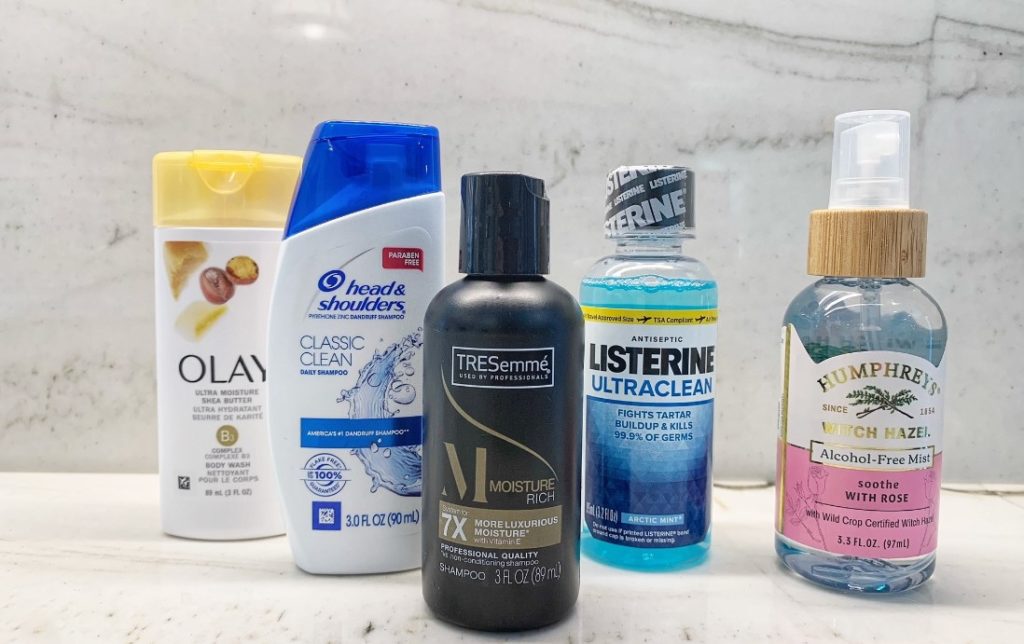
Most of the toiletries you would bring on a trip come in travel-sized packages that can be bought at any drug store or grocery store. These travel-sized items are typically 3 ounces (90 ml) and generally provide enough lotion, shampoo, or toothpaste for a 5-day trip. If you’ll be traveling longer, you may need to stock up on a couple of extra bottles or plan on purchasing more upon arrival at your destination.
100 milliliters (ml) converts to 3.3814 ounces (oz). For purposes of simplicity, the TSA rounds this up to 100 ml
100 milliliters (ml) converts to .422675 cups, so it’s just under 1/2 cup.
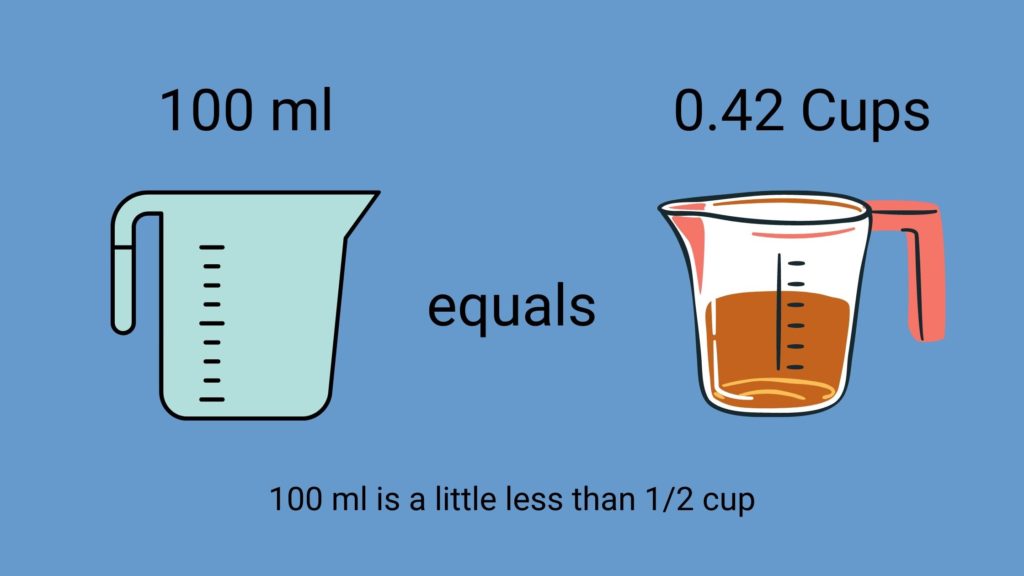
A 100 ml bottle is fairly small. To give you a visual, look at the image below that shows a 500 ml water bottle vs. a 100 ml spray bottle. The 100 ml bottle is about 3 inches tall and the water bottle is about 8 inches tall.
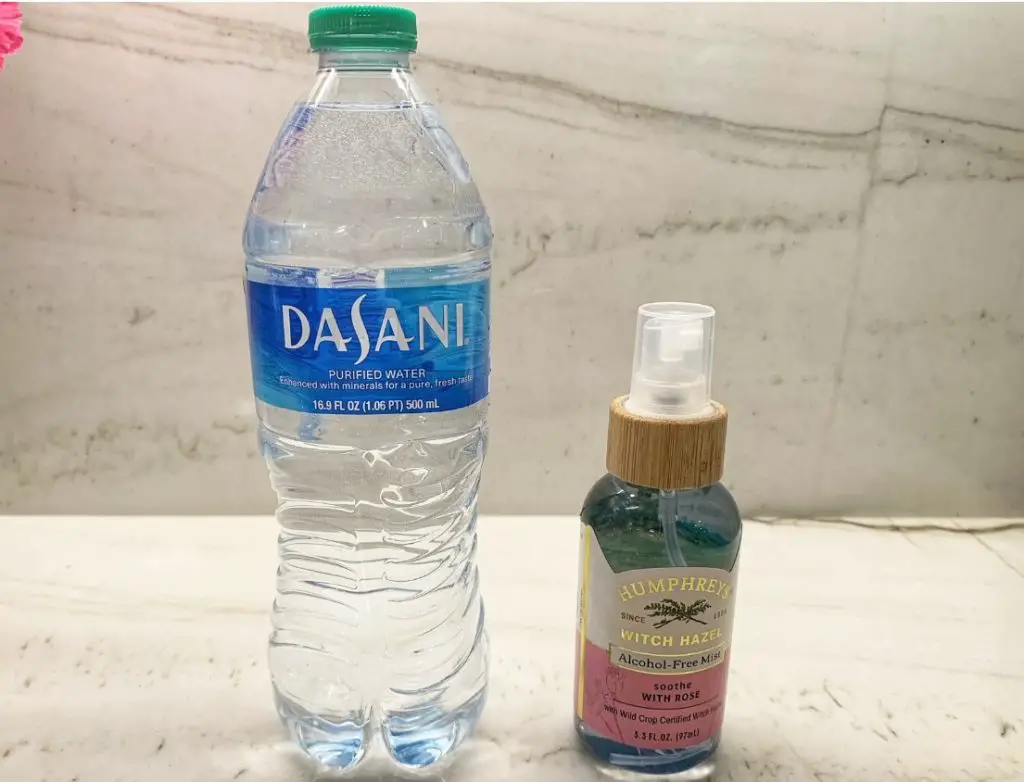
Hopefully, this guide will give you a better idea of what the TSA considers a liquid and what size they will let you bring on your carry-on. Knowing this information in advance can save a lot of headaches at the airport!
- Spirit Airlines Carry-On Liquid Policy
Tim is a business road warrior and avid leisure traveler who has flown over two million miles in the air and spent well over a thousand nights in hotels. He enjoys sharing tips, tricks, and hacks to help readers get the most out of their travel experience and learn how to “travel like a pro”!

Reader Interactions
Leave a reply cancel reply.
Your email address will not be published. Required fields are marked *
- Search Please fill out this field.
- Manage Your Subscription
- Give a Gift Subscription
- Newsletters
- Sweepstakes
- Travel Tips
Everything You Need to Know About TSA Liquid Rules
Get the details on flying with beauty products, medication, and other essential items.
:max_bytes(150000):strip_icc():format(webp)/Stefanie-Waldek-7eed18a8c9734cb28c5d887eb583f816.jpg)
Dealing with airport security can be a daunting aspect of air travel. There's a lot to contend with, from the long lines at checkpoints to keeping track of all the guidelines set by the Transportation Security Administration (TSA).
Travelers are frequently tripped up by the TSA liquid rules — specifically, the 3-1-1 policy regarding liquids in carry-on bags. From the detailed requirements for traveling with liquids to helpful packing tips, we explain everything you need to know before going through security.
What is TSA's 3-1-1 rule?
In 2006, British security officials thwarted a plot to bomb an aircraft with liquid explosives carried on board. Since then, security agencies around the world have limited the amount of liquid passengers can bring through airport security.
In the United States, TSA stipulates that all liquids, gels, and aerosols must be in 3.4-ounce (100-milliliter) containers or smaller. All liquids must fit into a single, clear quart-size bag, and passengers can only pack one of these bags in their carry-on.
The 3-1-1 designation is a simple way to remember these numbers: individual liquid containers must be 3.4 ounces or smaller, they must fit into one clear, quart-size bag, and there is only one bag allowed per passenger.
Permitted liquids that do not comply with the 3-1-1 rule must be packed in checked bags or thrown out at airport security. Some liquids, such as gasoline or other flammable liquids, are prohibited entirely, both in checked and carry-on bags.
Are there any exceptions to the 3-1-1 rule?
TSA does exempt some items from the 3-1-1 rule: medically necessary liquids, breast milk, infant formula, toddler drinks, and pureed baby food typically packaged in pouches. You can bring more than 3.4 ounces of these liquids on board, but you may have to undergo additional security screening.
"Inform the TSA officer at the beginning of the screening process that you're carrying them," TSA spokesperson Jessica Mayle tells Travel + Leisure . "These liquids are typically screened by X-ray, but TSA officers may also test them separately for explosives or concealed prohibited items. Officers may ask you to open the container and/or have you transfer a small quantity of the liquid to a separate empty container, or dispose of a small quantity, if feasible."
If you don't want your exempt liquids to be screened by X-ray, inform your TSA officer, and they will use alternative security measures to clear the items.
Another exception is liquids purchased after security in an airport. In domestic U.S. airports, you can bring nonalcoholic drinks and other liquid items purchased in terminal shops or eateries onto your flight. (This is not always the case if you are passing through security again in international airports for a connecting flight.) Duty-free liquids, however, will be sealed in a tamper-safe bag before boarding. Sometimes they're permitted in the cabin, and other times they may be stowed elsewhere on the plane.
You can also pass through security with liquids that have been frozen solid . By taking this extra step, you can easily tote your favorite drink past security — even if it's well over three ounces.
Rules about partially frozen items do not apply to some childcare items, such as ice or gel packs used to transport breast milk, formula, or baby food, or gel- or ice-filled baby teething toys. If these items are not completely frozen, they will be screened using the same procedures as medically necessary items. While hand sanitizer must conform to the 3-1-1 rule, wet wipes are allowed.
Packing Tips for Liquids in Carry-on Bags
- While many products are sold in 3.4-ounce sizes suitable for travel, not all of them are. Consider decanting your liquids into leakproof travel-size containers.
- "Another way to save space in your quart-sized bag is to pack solid versions of products, which you can put in your luggage or carry-on bag without needing to place it in the quart-size bag," travel advisor Ateet Ahuja of Complete Getaways tells T + L. "For example, you can bring a stick or solid version of some perfumes and shampoo bars instead of liquid shampoo." This solid Korean sunscreen stick is affordable and easy to pack.
- Buy your liquids, like body lotion or mouthwash, at your final destination. "While you'll spend a little extra, the cost far outweighs the potential of it spilling or leaking in your bag," says Ahuja.
- On that note, prepare for spills — Ahuja advises wrapping a small hand towel around your quart-size bag.
- Pack your liquids bag in an easy-to-access place, like an external compartment or the top of your carry-on bag. According to Ahuja, "This will save you time in the TSA line."
- Check the allowance for specific items using TSA's What Can I Bring? list . Here you'll find answers regarding everything from gel-style candles — not allowed — to dry ice, which requires airline approval rather than TSA approval.
If you're unsure about whether an item not listed adheres to the 3-1-1 rule, you can contact TSA before your trip. "Ask your questions via Facebook Messenger , weekdays from 8 a.m. to 6 p.m. ET," says Mayle. "You can also call the TSA Contact Center at 866-289-9673."
Related Articles

An official website of the United States government
Here’s how you know
Official websites use .gov A .gov website belongs to an official government organization in the United States.
Secure .gov websites use HTTPS A lock ( Lock A locked padlock ) or https:// means you’ve safely connected to the .gov website. Share sensitive information only on official, secure websites.
Travel Tips: 3-1-1 liquids rule
You are allowed to bring a quart-sized bag of liquids, aerosols, gels, creams and pastes through the checkpoint. These are limited to 3.4 ounces (100 milliliters) or less per item. This is also known as the 3-1-1 liquids rule.
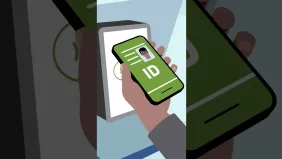
Liquids Allowed in Carry-On Luggage
:max_bytes(150000):strip_icc():format(webp)/OR-DK-bw-56a0d4c93df78cafdaa56d5e.jpg)
Joe Raedle / Staff / Getty Images
If you're taking a flight for your vacation, you need to know the quantities and types of liquids that the Transportation Safety Administration (TSA) allows passengers to bring onto an airplane in their carry-on luggage .
While good security is essential, TSA's regulations on liquid quantities certainly make it harder to take some necessary items on planes. Today’s travelers have to pay attention to exactly what they’re carrying, especially when it comes to shampoos, shaving cream, drinks, and anything resembling a fluid, as many of the TSA's rules forbid these items in certain quantities.
The TSA and airport screeners are strict about the amount and type of liquids that travelers can take with them on the plane. However, they've fortunately developed a handy guide to help passengers prepare for their trip. Known as the 3-1-1 rule for carry-on liquids, this rule states that most liquids, gels, and aerosols can be transported as long as each item is in a 3.4-ounce or smaller container and all items fit in a single one-quart plastic zip-top bag.
The 3-1-1 Rule
According to the 3-1-1 guidelines, travelers, in general, are allowed to bring on most liquids, from shampoo to hand sanitizer gels, as long as they meet the requirements of the 3-1-1 rule. Typically this means you can carry up to six 3.4-ounce bottles of shampoos, contact solution, and other liquid necessities as long as they are all contained within a zip-top bag.
You can also put liquids in your checked luggage (as long as they’re not prohibited items). However, if you do this, you should make sure the liquids are sealed really well so that they don't come up while being transported beneath the aircraft. The last thing you need on a business trip is to have your shampoos or other liquids leak all over your business suit or wardrobe. Fortunately, there are plenty of great TSA-approved travel toiletry bottles available to choose from.
Special Liquids and Larger Quantities
Travelers can also declare larger containers of selected liquids, such as baby formula or medications , at the checkpoint. Airport screeners will generally allow them in moderate quantities, and declared liquids don’t have to be in zip-top bags.
Medications, baby formula and food , and breast milk are allowed in reasonable quantities exceeding three ounces, but you'll need to declare these items for inspection at the checkpoint. Also, it's worth noting that TSA screeners do allow you to bring ice through the security checkpoint as long as it's frozen solid. So if you bring ice, make sure to dump out any water before you hit the security checkpoint.
Examples of liquids that can be in excess of the 3.4-ounce rule include:
- Baby formula, breast milk, and juice (for babies)
- Both prescription and over-the-counter medications
- Liquids or liquid nutrition for people with disabilities or medical conditions
- Specialized medical liquids like contact solution
- Frozen items, if they’re frozen solid
- Medical or cosmetic items with liquid or saline
If you’re attempting to bring one of the above items with you, the TSA requires you to separate them, declare them to a security officer, and present them for additional screening. For complete information on the 3-1-1 rule, visit the TSA website, and for a complete list of prohibited items, visit the official TSA prohibited items list.
Why the TSA Limits Liquids
While it may seem like an arbitrary rule to some, the TSA 3-1-1 Rule actually took a considerable amount of negotiation and research to implement and was developed in response to an attempted attack on an airport in the United Kingdom.
On August 10, 2006, authorities in the United Kingdom arrested a group that was planning to destroy a number of airplanes by using an explosive mixture of a sports drink and other chemicals. After the arrest, the TSA rigorously tested a wide variety of liquids to determine which should be banned outright and what quantity of common household liquids was safe for passengers to bring aboard.
The United States adopted the 3-1-1 Rule in September of 2006, and the TSA screens all arriving international flights to make sure passengers comply with domestic regulations. Other countries have since adopted the same or similar regulations in order to ensure uniform administration of safety rules around the world. Canada, China, South Korea, New Zealand, Australia, and all member states of the European Union follow the 3-1-1 Rule.
The 7 Best Travel Toiletry Bottles of 2024, Tested and Reviewed
Taking Your Prescription Drugs Through Airport Security
Best Ways to Prepare for Airport Security Screenings
3-1-1 Rule for Liquids in Carry-on Bags
TSA Rules for Traveling with Food
Survival Tips for Air Travel with an Infant or Toddler
Top Flying with Luggage Tips
Get Ready to Go Through Airport Security
Air Travel Tips for Grandparents Traveling With Grandchildren
Rules for Liquids in Checked Baggage: The Complete Guide
How to Bring Duty Free Liquids Into the US in a Carry-On Bag
The 9 Best Travel Toiletry Bags of 2024, Tested and Reviewed
Airport Security Rules and Regulations
Keep These Items out of Your Carry-On Bag
TSA Requirements and Advisements for Air Travel
The 12 Best Carry-On Luggage of 2024, Tested and Reviewed

IMAGES
VIDEO
COMMENTS
Each passenger is limited to one quart-size bag of liquids, gels and aerosols. Common travel items that must comply with the 3-1-1 liquids rule include toothpaste, shampoo, conditioner, mouthwash and lotion.
TSA's 3-1-1 Liquids Rule. You are allowed to bring a quart-sized bag of liquids, aerosols, gels, creams and pastes in your carry-on bag and through the checkpoint. These are limited to travel-sized containers that are 3.4 ounces (100 milliliters) or less per item.
In short, the 3-1-1 rule is: Each liquid you bring through the TSA checkpoint must be in a 3.4-ounce or smaller container ("3"), all containers must be placed inside one clear quart-size plastic bag ("1") and each passenger is only allowed one plastic bag ("1").
You might be surprised to learn that you can bring travel-size bottles of alcohol in your carry-on or that you can't carry creamy dips or spread as a snack in your suitcase if it exceeds 3.4 ounces, but knowing these rules will help you avoid additional screening at the TSA checkpoint.
What is the TSA liquid limit? The TSA’s liquid limit for carry-ons—known as the 3-1-1 rule—allows travelers to pack liquids, aerosols, gels, creams, and pastes under 3.4 ounces (100 milliliters) in their carry-on bags.
The TSA liquids rule states that you can bring a quart-sized bag of liquids, aerosols, creams, gels, and pastes in your carry-on bag and through the airport security checkpoint. However, you are limited to containers that are travel sized and contain less than 3.4 ounces (100 milliliters) per item. image: TSA.
In the United States, TSA stipulates that all liquids, gels, and aerosols must be in 3.4-ounce (100-milliliter) containers or smaller. All liquids must fit into a single, clear quart-size...
You are allowed to bring a quart-sized bag of liquids, aerosols, gels, creams and pastes through the checkpoint. These are limited to 3.4 ounces (100 milliliters) or less per item. This is also known as the 3-1-1 liquids rule. Select Filter.
The 3-1-1 Rule. According to the 3-1-1 guidelines, travelers, in general, are allowed to bring on most liquids, from shampoo to hand sanitizer gels, as long as they meet the requirements of the 3-1-1 rule.
3D scans of passenger bags can eliminate the need for 100-ml restrictions on airplane hand luggage. Some airports already have the tech, indicating changes could be on the way after years of...